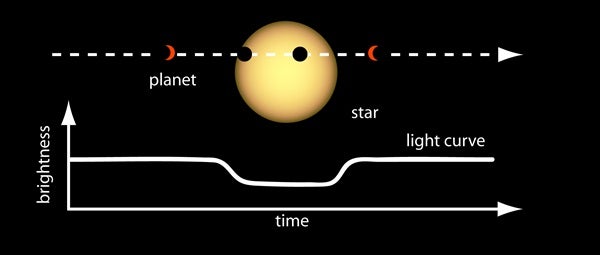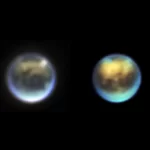Key Takeaways:
- If other intelligent life exists, they could potentially detect Earth transiting the Sun from their vantage point.
- Researchers created a list of about 1,000 stars with planets that could potentially see Earth transiting the Sun.
- By observing dips in a star’s brightness, astronomers can learn about the size, orbit, and even atmosphere of an exoplanet.
- The presence of certain gases like oxygen in an exoplanet’s atmosphere could indicate biological activity.
Since 1992, when astronomers discovered two rocky planets orbiting a pulsar in the constellation Virgo, humans have known that there are other worlds beyond our solar system. More than 4,000 confirmed exoplanets exist today, thanks to the efforts of astronomers and ambitious missions such as the now-retired Kepler.
If we can see exoplanets orbiting distant stars, then extraterrestrial observers should be able to see Earth orbiting the Sun. Our tiny blue marble could even appear on an alien astronomer’s list of rocky exoplanets capable of supporting life.
That is, of course, a speculative scenario, but astronomers continue to take it seriously. Several papers have been published over the years identifying which exoplanets would be able to detect Earth. And now, using updated data from the European Space Agency’s large Gaia catalog of nearby stars, two researchers have provided us with what may be the best list yet of which alien worlds are keeping an eye on us.
Observing Earth from afar
Joshua Pepper, an astronomer at Lehigh University and coauthor of the recent paper, which was published in Monthly Notices of the Royal Astronomical Society, says it all started with a few simple questions.
According to Pepper, the best way to find exoplanets right now is to observe a planet pass in front of its star, also known as a transit. That made it an obvious choice for how other planets might detect us.
“What if there were intelligent beings on another planet? And if they were looking at the Earth, which of those star systems could they be living in that would enable them to see Earth?” he says.
Pepper and Lisa Kaltenegger, director of Cornell University’s Carl Sagan Institute, used data from Gaia and NASA’s Transiting Exoplanet Survey Satellite (TESS) to search for planets that were in alignment with Earth’s orbit around the Sun.
This would allow alien observers to see the Sun’s brightness drop a bit whenever Earth passes in front of it. They ended their search at around 330 light-years and excluded some stars with poor data, resulting in a list of approximately 1,000 stars properly aligned with Earth’s orbit.
According to Pepper, the best way to find exoplanets right now is to observe a planet pass in front of its star, also known as a transit. That made it an obvious choice for how other planets might detect us.

So far, the researchers claim to have discovered five exoplanets close enough to Earth that extrasolar astronomers could theoretically see us. From those worlds, Earth would appear as a small blob of shadow passing in front of our Sun.
Although five exoplanets indicate a small fraction of all the worlds out there, Pepper believes their list could be a good starting point for researchers working on the Search for Extraterrestrial Intelligence, or SETI.
“This could be a target list for SETI searches,” he says. “Any aliens on those planets would be uniquely positioned to know about the Earth.”
Earth, the Exoplanet.
From many light-years away, Earth would not appear particularly impressive. Anyone viewing Earth as a transiting exoplanet would not see our planet as a verdant oasis filled in blue, green, and tan, as we do in close-up satellite images. They’d simply see a lump of rock blocking the Sun.
However, astronomers can still learn a lot by observing how a planet dims its own star. They can estimate the planet’s size, the rate at which it orbits its star, and even its density, which determines whether it is a gas giant like Jupiter or a rocky planet like Earth. For example, we already know about the five planets that Pepper and Kaltenegger believe may be able to see us: they are thought to be super-Earths, larger than Earth but smaller than Uranus and Neptune.
As a planet passes in front of its star, astronomers also have a rare opportunity to peer into its atmosphere (if it has one). When a thin sliver of starlight passes through the world’s gaseous envelope, it picks up information about what the atmosphere is made of.
“When it emerges, that light is imprinted with the molecular signature of the gases that were in the atmosphere,” Pepper explains. Using this data, astronomers can piece together the composition of exoplanet atmospheres. While this is a difficult task, it provides astronomers with one of the most effective methods of searching for life in the universe. That’s because the presence of oxygen or other molecules that wouldn’t exist without biological life would be a good indicator of extraterrestrial life on another planet.

Earth, for example, would appear quite interesting to an alien astronomer parsing the complex contents of our atmosphere. Relatively high levels of oxygen, methane, carbon dioxide, and other gases could be a strong indication that our planet is thriving with life.
“As far as we know, [an] atmosphere like the Earth [has], there’s really no way to mimic that without life,” Pepper says.
An even stronger sign of extraterrestrial life could come from electromagnetic signals, like the radio waves that emanate from our telecommunications equipment. SETI is currently searching for these signals elsewhere in the universe.
Those efforts have yielded a few candidate signals over the years, but nothing close to convincing evidence. For example, earlier this month, press reports surfaced about an intriguing signal discovered by the Breakthrough Listen project, which appeared to come from the star Proxima Centauri. However, the researchers have carefully noted that, while they cannot yet explain the source of the signal, human interference is the most likely source.
However, if extraterrestrials were to train an equivalent to the Green Bank Observatory on Earth, they’d see a planet abuzz with electromagnetic activity. It would be a fairly obvious indication that our planet contains far more than just rocks and water.
Another planet would not need to see the Earth pass in front of the Sun to detect our electromagnetic radiation. However, Pepper claims that their research focuses on planets that are most likely to encounter Earth. Seeing us silhouetted in front of our star is one of the most effective ways to accomplish this.
Of course, whether we want another planet to find us is a completely different question.


